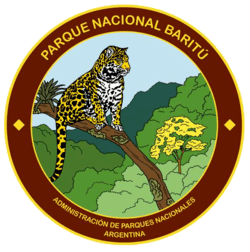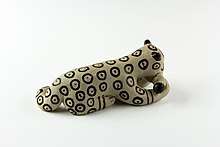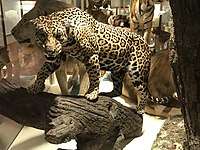South American jaguar
The South American jaguar[1] is a population of the jaguar in South America.[2][3] Though a number of subspecies of jaguar have been proposed for South America,[4] morphological and genetic research has not found any evidence for subspecific differentiation.[5][6] It is considered to be the biggest cat in the New World.[3]
Taxonomic history

Initially, a number of subspecies were described for South America:[3]
- Panthera onca onca was proposed by Reginald Innes Pocock in 1939.[2][3]
- Pocock also mentioned other subspecies, such as Panthera onca peruviana (de Blainville, 1843),[8] but eventually, due to a lack of evidence, he accepted that Panthera onca peruviana could be the same subspecies as Panthera onca onca. In other words, the taxonomic name Panthera onca onca referred to a geographic group, if not subspecies, of jaguars north and west of the Amazon River, and south of Central America, including some Colombian jaguars, which was believed to include another group of jaguars, that is Panthera onca centralis.[3][6][9][10]
- The Pantanal jaguar was proposed as the largest subspecies, with the taxonomic name Panthera onca palustris (Ameghino, 1888), native to the Pantanal region of South America, besides Argentina.[3]
- A specimen from Bolivia was given the name Panthera onca boliviensis (Nelson and Goldman, 1933), before it was considered as being of Panthera onca palustris by Carbera (1957).[11]
- Panthera onca paraguensis (Hollister, 1914) was described for a jaguar from the Gran Chaco or the Pantanal regions in Paraguay.[3][12]
Morphological research has failed to find evidence for subspecific differentiation.[5]
Characteristics

_male_meeting_a_young_female_(back)_..._-_Flickr_-_berniedup.jpg)
Jaguars are considered to be larger than cougars, and those in South America tend to be heavier than those in Central or North America. Within South America, there are differences for jaguars which are north and south of the Amazon River.[3]
In Guyana, specimens weighing up to 200 lb (91 kg) have been reported.[13] The average for males and females in Venezuela was 95.0 kg (209.4 pounds) and 56.3 kg (124 pounds) respectively,[14] with the latter being similar to that of Central American males in Belize.[3] Venezuelan males and females can otherwise weigh up to 120 kg (260 lb) and 90 kg (200 lb), respectively.[15]
Certain jaguars from the Pantanal region are the largest of the species, with lengths of about 2.7 m (8.9 ft), and average weights of 94.8 kg (209 lb) for males and 77.7 kg (171 lb) for females.[16] Some individuals weighed more than 135 kg (298 lb).[17]
Habitat and distribution
In Peru, the jaguar is found in the Pacaya-Samiria National Reserve, and Manú National Park.[3][9] Jaguars disappeared in a number of places, like the Pampas' part of Argentina and Uruguay.[18]
Behavior and ecology
In South America, the jaguar's prey includes the peccary,[1] capybara,[7][19] and green anaconda.[20] Sympatric predators include the mountain lion and spectacled bear. Spectacled bears appear to avoid places where the jaguar is present. This suggests predation on the bear by the jaguar.[21]
_frustrated_male_in_%22flehmen%22_attitude_..._No_mating_for_now_%5E_-_Flickr_-_berniedup.jpg) Male giving a Flehmen response near the Cuiabá River
Male giving a Flehmen response near the Cuiabá River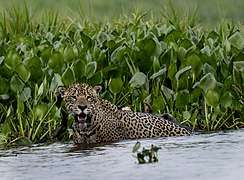 Male crossing a river in search of a female in the northern Pantanal
Male crossing a river in search of a female in the northern Pantanal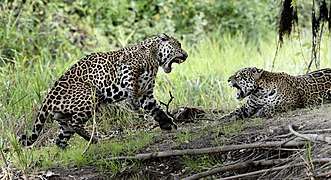 A couple in a standoff
A couple in a standoff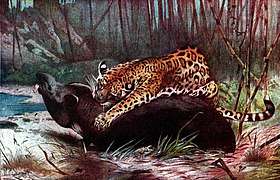 Illustration of a jaguar preying on a tapir
Illustration of a jaguar preying on a tapir
Attacks on humans
Occasionally, jaguars may attack humans, depending on factors such as the availability of natural prey:[7]
- In 2015, at Isseneru Village in Cuyuni-Mazaruni, near the Mazaruni River in the Guyana Montane Forest, a jaguar attacked an indigenous girl aged three. She later received medical treatment, and survived.[13]
- A fatal attack on a child belonging to the Taushiro people, who are from the border region of Peru and Ecuador, had been reported. In fact, the child's grandfather used to warn his family about such attacks.[22]
Threats
In Bolivia, jaguars are threatened by the illegal trafficking of their parts, including fangs to China. They are also threatened by the removal of habitat, and conflict with humans.[23]
Cultural significance
The jaguar is featured in the crest of Argentina's national federation in rugby union.[24] Jaguares de Córdoba is a football team in Colombia.[25] The Lost Land of the Jaguar is a nature documentary by the BBC on Guyana's fauna, including the jaguar.[26]
Juma
During the relaying of the torch at the 2016 Summer Olympics in Brazil, a female, captive jaguar in Manaus called 'Juma' was used as a mascot. However, it tried to escape, and on approaching a person, was killed. The animal's death provoked outrage, similar to that of a captive gorilla earlier.[27][28]
Gallery
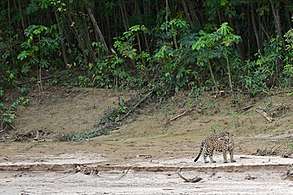
- Male near Three Brothers River, Northern Pantanal
.jpg)
.jpg) A captive jaguar in Santa Cruz Zoo
A captive jaguar in Santa Cruz Zoo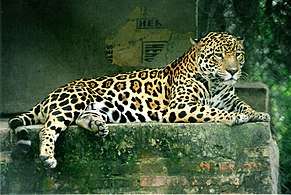 In a wildlife rescue and rehabilitation center in Formosa Province, Argentina, August 1998
In a wildlife rescue and rehabilitation center in Formosa Province, Argentina, August 1998)_(17972328810).jpg) A jaguar killed by Theodore Roosevelt[1]
A jaguar killed by Theodore Roosevelt[1]
See also
References
- 1 2 3 Dickerson, M. C. (1915). The American Museum Journal. p. 46.
- 1 2 Pocock, R.I. (1939). "The races of jaguar (Panthera onca)". Novitates Zoologicae (41): 406–422.
- 1 2 3 4 5 6 7 8 9 10 Seymour, K. L. (1989). "Panthera onca" (PDF). Mammalian Species. 340 (340): 1–9. doi:10.2307/3504096. JSTOR 3504096. Archived from the original (PDF) on 20 June 2010. Retrieved 27 December 2009.
- ↑ Wozencraft, W.C. (2005). "Order Carnivora". In Wilson, D.E.; Reeder, D.M. Mammal Species of the World: A Taxonomic and Geographic Reference (3rd ed.). Johns Hopkins University Press. pp. 546–548. ISBN 978-0-8018-8221-0. OCLC 62265494.
- 1 2 Larson, S. E. (1997). "Taxonomic re-evaluation of the jaguar". Zoo Biology. 16 (2): 107–120. doi:10.1002/(SICI)1098-2361(1997)16:2<107::AID-ZOO2>3.0.CO;2-E.
- 1 2 Ruiz-Garcia, M.; Payan, E.; Murillo, A. & Alvarez, D. (2006). "DNA microsatellite characterization of the jaguar (Panthera onca) in Colombia". Genes & Genetic Systems. 81 (2): 115–127. doi:10.1266/ggs.81.115. Retrieved 2015-09-08.
- 1 2 3 Porter, J. H. (1894). Wild beasts; a study of the characters and habits of the elephant, lion, leopard, panther, jaguar, tiger, puma, wolf, and grizzly bear. p. 239.
- ↑ Nowak, Ronald M. (1999). Walker's Mammals of the World. 2. Baltimore: Johns Hopkins University Press. p. 831. ISBN 0-8018-5789-9.
- 1 2 Nowell, K.; Jackson, P. (1996). "Panthera Onca". Wild Cats. Status Survey and Conservation Action Plan (PDF). Gland, Switzerland: IUCN/SSC Cat Specialist Group. pp. 118–122. Retrieved 2015-09-07.
- ↑ Caso, A.; Lopez-Gonzalez, C.; Payan, E.; Eizirik, E.; de Oliveira, T.; Leite-Pitman, R.; Kelly, M. & Valderrama, C. (2008). "Panthera onca". IUCN Red List of Threatened Species. Version 2016-3. International Union for Conservation of Nature.
- ↑ Wozencraft, W.C. (2005). "Panthera onca". In Wilson, D.E.; Reeder, D.M. Mammal Species of the World: A Taxonomic and Geographic Reference (3rd ed.). Johns Hopkins University Press. p. 546. ISBN 978-0-8018-8221-0. OCLC 62265494.
- ↑ Nowell, K.; Jackson, P., eds. (1996). "Panthera Onca". Wild Cats. Status Survey and Conservation Action Plan (PDF). Gland, Switzerland: IUCN/SSC Cat Specialist Group. IUCN. pp. 118–302. Retrieved 2015-09-07.
- 1 2 Francis, Adama M.; Iserson, K. V. (2015). "Jaguar Attack on a Child: Case Report and Literature Review". Western Journal of Emergency Medicine. 16 (2): 303–309. doi:10.5811/westjem.2015.1.24043. PMC 4380383. PMID 25834674.
- ↑ Mondolfi, E.; Hoogenstein, R. (1986), "Status of the jaguar in Venezuela", Cats of the World: biology, status and conservation, Washington D. C.: National Wildlife Federation, pp. 85–123
- ↑ Novak, R. M.; Walker, E. P. (1999). "Panthera onca (jaguar)". Walker's Mammals of the World (6th ed.). Baltimore: Johns Hopkins University Press. pp. 829–832. ISBN 0-8018-5789-9.
- ↑ Schaller, G. B.; Vasconselos, J. M. C. (1978), Jaguar predation on capybara (PDF), 43 (296–301), Z. Säugetierk
- ↑ "Brazil nature tours, Pantanal nature tours, Brazil tours, Pantanal birding tours, Amazon tours, Iguazu Falls tours, all Brazil tours". Focustours.com. Archived from the original on 2007-12-28. Retrieved 2007-02-28.
- ↑ "Subespecies del Jaguar". AnimalesExtincion (in Spanish). Retrieved 2015-09-11.
- ↑ Bristol Zoo Gardens (UK) ''Capybara'' Archived 2007-09-18 at the Wayback Machine.. Bristolzoo.org.uk. Retrieved on 2011-12-07.
- ↑ Eunectes murinus (Green Anaconda): Cannibalism Archived 2010-03-01 at the Wayback Machine. at Prodigy Archived 2010-03-13 at the Wayback Machine.. Accessed 3 July 2008.
- ↑ Servheen, C.; Herrero, S.; Peyton, B. (1999). Bears: Status Survey and Conservation Action Plan (PDF). Missoula, Montana: IUCN/SSC Bear Specialist Group. ISBN 978-2-8317-0462-3.
- ↑ Casey, Nicholas (2017-12-26). "Thousands Once Spoke His Language in the Amazon. Now, He's the Only One". New York Times. Retrieved 2017-12-26.
- ↑ Navia, R. (2018-01-26). "Fang trafficking to China is putting Bolivia's jaguars in jeopardy". Mongabay.com. Retrieved 2018-02-01.
- ↑ Davies, Sean (2007-07-26). "Puma power: Argentinian rugby". bbc.co.uk. Retrieved 2007-10-08.
- ↑ "Jaguares de Córdoba". Soccerway.com. Retrieved 2013-06-23.
- ↑ "Lost Land of the Jaguar". BBC One. Retrieved 2012-08-05.
- ↑ "Amazon jaguar shot dead after Olympic torch ceremony". Reuters. 2016-06-21. Retrieved 2018-01-21.
- ↑ "Rio 2016: Jaguar in Amazon torch relay shot dead". BBC News. 2016-06-22. Retrieved 2018-01-21.
